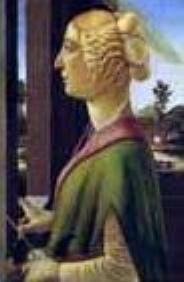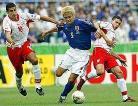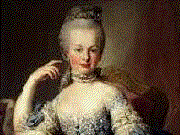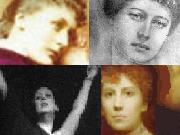Womania
| Caterina Sforza |
| Table of Contents |
Books on eBay ???
Why not!
Click the picture below!
Enter the BOOKS category and
Find fun and bargains!

Caterina’s Birthday
 The exact date of Caterina’s birth cannot be ascertained. The suggestion of a late 1462 birth date rests on
fragmentary evidence. Galeazzo Maria’s
letters of,
and actions during, the late spring and the early summer of
1462 show him unusually contrite and subservient to his
parents. His changed behavior could easily be interpreted as an
embarrassment of the young man over the second pregnancy of
Lucrezia Landriani.
The exact date of Caterina’s birth cannot be ascertained. The suggestion of a late 1462 birth date rests on
fragmentary evidence. Galeazzo Maria’s
letters of,
and actions during, the late spring and the early summer of
1462 show him unusually contrite and subservient to his
parents. His changed behavior could easily be interpreted as an
embarrassment of the young man over the second pregnancy of
Lucrezia Landriani.
The naming of the baby girl does not follow either a Sforza or a Landriani tradition. It could be suggested, therefore, that the girl was either born or named on the day of Saint Catherine, November 25.
Most historians place the birthday somewhere between late 1462 and early 1463.
In any case, no festivities greeted Caterina when she was born. The Sforza sent no letters of joy to foreign courts announcing the birth of a new Sforza. Birth in obscurity was followed by a few years during which Caterina grew up on a limbo.
Her father was not yet the duke, and his resources for taking care of the product of his passionate pastimes were limited. In addition, months before Caterina’s birth, Galeazzo Maria had begun to strive for a better relationship with his parents and was less willing than before to parade the fruits of his sexual liaison before the world. His youthful taste for defiance of his parents had found temporary satisfaction, and he approached them, not as a repentant son, but at least as an obedient son.
While Lucrezia had been bearing his child, Galeazzo had been clamoring for more meaningful news from the court—marriage to a princess.
Traces of respect for his parents reappeared in his letters. Galeazzo even expressed his willingness to avoid repeating grave errors. But all of this did not really reform his behavior. Instead, he merely became more discreet about it. And his affair with Lucrezia continued.
Galeazzo’s energies were gradually diverted into a greater variety of activities. Renewed travel occupied a part of his time. Some of these trips brought him together with Dorotea Gonzaga, who was still destined to become his wife. From the time the two met in 1458, they had exchanged pleasantries in letters.
Their relationship was full of irony. Galeazzo Maria and Dorotea acted like persons who were genuinely fond of each other. Theirs was a mutual affection of remarkable tenderness at a time when Galeazzo Maria was finding his pleasure in the arms of Lucrezia Landriani and a time too when Duke Francesco had decided to drop the Gonzaga marriage in favor of a tie with some more important family.
Galeazzo saw her in 1458, 1461, 1462, and 1463. It is reported that he cried when the break became final.
On the surface, Galeazzo Maria showed no sorrow over the shelving of the Gonzaga marriage plans by his father’s deliberate insistence on a medical examination of Dorotea for a possible deformation of the spine. Pride forbade the Gonzaga to permit this, and the marriage became a remote possibility. Sforza relations with France were, however, carefully nurtured, and Galeazzo Maria was the instrument of that policy.
In August, 1465, an extraordinary corps under Galeazzo’s command left Milan to assist Louis XI in the struggles connected with the War of the Public Weal. Galeazzo did well and scored a military success, though an experienced professional soldier, Gaspare da Vimercate, had much to do with that. Without any doubt, this result pleased the French king.
Then in March 1466, Galeazzo had to hurry home. Duke Francesco had died. He became the new riler of Milan.
Milan greeted the young duke with all the pomp and circumstance he could expect; everybody of consequence took part in the welcoming ceremonies. But Lucrezia and Giampietro Landriani were not among the well-wishers. Their hour of prominence had come too early, when Galeazzo Maria could not repay favors accorded him. Now that he could, his passion for Lucrezia had cooled.
However, She was still his mistress (and soon pregnant for the fourth time) but increasingly had to share the favors of the young duke with other ladies. Lucrezia’s husband had condoned his cuckolding for little gain. The list of Galeazzo Maria’s dependents and the distribution of gifts to trusted friends, show that Giampietro was left out. Yet the three-year-old Caterina, a Landriani herself, did not suffer from the eclipse of her mother’s and stepfather’s influence.
Caterina was accepted into the new Sforza household over which her paternal grandmother, Bianca Visconti-Sforza, presided.
Bianca Visconti-Sforza, a lady of vigor and spirit, must have liked Caterina, since the girl showed signs of a similar disposition.
Galeazzo took on the responsibility for Caterina’s welfare at the same time that he began to rule one of the great powers of Renaissance Italy. Between his concern with state business and his pursuit of private pleasures he had little time for a serious participation in Caterina’s upbringing. On occasion, however, he showed his awareness of his father role even in the midst of pressing affairs of war and politics.
In 1467, when Galeazzo was in the field in connection with the Colleoni war, he showed himself genuinely distressed by the news of Caterina’s sickness. The girl, then four and one-half years old, apparently suffered an attack of one of the numerous diseases to which, in that period, so many infants were lost. Galeazzo’s wish to be kept informed about the course of the sickness displayed an urgency beyond dutiful interest. Caterina recovered and soon after experienced a decisive change in her life.
Depressions had haunted Dorotea Gonzaga ever since her dream of becoming Galeazzo’s wife had been shattered. In 1467 she died. With all possible legal obstacles to a marriage removed, Galeazzo wasted no time in satisfying his desire for a household of his own. The continuation of the Sforza line depended on it, and the prospect of reducing his mother’s influence would be enhanced by it.
Duke Francesco, in the interest of Italian politics, had been reluctant to consider the ruling families of France and Savoy for dynastic ties. Galeazzo knew no such restraints. During the spring and summer of 1468 negotiations were conducted with the French and the Savoyards.
From the talks came the suggestion that Galeazzo should marry Bona of Savoy, sister of Duke Amadeus IX of Savoy and close relative of Louis XI of France.
Bona of Savoy turned out a short and stocky girl with a high forehead, blond hair, an extremely thick neck, and a foreshortened chin. Galeazzo, a connoisseur of women, must have noticed how much she already resembled a matron. But after seeing her portrait drawn by the Milanese artist Zanetto Bugatti, he showed the excitement of an infatuated adolescent rather than the detached attitude of the participant in a dynastic match.
The proxy marriage was performed. Weeks later the couple met and consummated the marriage. Within months the position of Bianca became untenable. The aged ex-duchess gave up all her attempts to rule with her son and went into voluntary exile to her dowry town of Cremona. On the way to that city Bianca suddenly died in October 1468. Galeazzo had rid himself of a person whose well-meant interference he had resented all along. Bona of Savoy became the unchallenged lady of the Sforza household.
Six-year-old Caterina experienced the change of generations in the Sforza family, too. Bianca Visconti-Sforza had been a highly respected figure. The noble lady had given Caterina a sense of security and even of human warmth. Now Bona of Savoy, nineteen years old, attempted to fill the mother role assigned to her. She did so in new surroundings for Caterina, since the Sforza had moved from the Arengo Palace into the Castello Sforzesco shortly after the ducal wedding.
Despite her inexperience and her own struggles with the complications of early marriage, she did well. Carlo, Caterina, Chiara, and Alessandro (Galeazzo Maria’s children by Lucrezia Landriani) cherished the gaiety and youthful exuberance of their new stepmother, who gave love even to those who constantly reminded her of her husband’s still unbridled sexual escapades. No less attention was paid to the four bastards after Bona had given birth to the fondly expected heir, Gian Galeazzo (1469).
Caterina always thought of her children as a pleasant period and knew that she had to thank Bona for it. Caterina’s father made every decision concerning her life, even such minor ones as the purchase of shoes and clothing. He provided well. Yet it was Bona who offered the growing girl the gentle guidance and warm companionship Caterina longed for in her splendid but bewildering world. All through her life Caterina remembered her father with pride, but she felt deeply grateful to her stepmother.
Caterina’s years of carefree playing came to an end when Bona entered her life. Tutors went to work on the little girl, introducing her to the rudimentary skills of reading and writing. While Caterina struggled to master the abecedario, simple prayers, and some life stories of saints, changes of great import for the future as a woman were in the offing.
Galeazzo began to use her as a pawn in the marital chess game as the other Renaissance dynasties did. Her betrothal, however, disturbed neither the dreams nor the routine of Caterina’s childhood. Indeed, few things did in those years.
In 1471 Galeazzo and Bona prepared for a visit to Florence to strengthen the ties with the new signore, Lorenzo de’Medici”. Caterina must have longed to join the pompous caravan that left Milan in May. It awed not only the young girl but also the contemporary chroniclers, who recount with ill-concealed disapproval the members of the traveling group. At its head came fifty steeds with saddles of cloth-of-gold, mounted by fifty youths in doublets of cloth-of-gold and silk and displaying silver stirrups. The coaches followed, some of them drawn by four, others by two horses covered with ornamental cloth with silken and golden fringes.
The ducal coach was especially splendid with its cloth-of-gold cushions and its horses covered with silver trappings. It was trailed by two thousand horses, two hundred mules, five hundred dogs, a great number of falcons and hawks, buffoons, servants, and forty pipers and tambours. But Caterina, and other children, including the infant Gian Galeazzo, were left behind.
Two months later, a message arrived from Rome announcing the death of Pope Paul II. Shortly afterward, the good news followed that the candidate whom the Sforza had supported, Francesco della Rovere, cardinal of San Pietro in Vincoli, had prevailed in the conclave. So began in earnest the course of developments that would eventually join the still obscure Rovere-Riario and the already powerful Sforza. The repercussions of the papal election of 1471 brought about a decisive turn in Caterina’s life.
| Copyright Akira Kato About this author:
|

|
Brazil 3 - 0.
 Possibly the most infamous goal in the World Cup was scored in 1986, when archrivals Argentina and England met. Argentina’s Diego Maradona leapt high for a ball and used his hand to tap it past the goalkeeper and into the net. The goal became known as the “The Hand of God”.
Possibly the most infamous goal in the World Cup was scored in 1986, when archrivals Argentina and England met. Argentina’s Diego Maradona leapt high for a ball and used his hand to tap it past the goalkeeper and into the net. The goal became known as the “The Hand of God”.
The 1950 World Cup was the only competition without a real final. Host Brazil needed only a draw against Uruguay to win. A world record 200,000 fans watched as Uruguay came from behind to win 2 -1.
 For a few, winning in the World Cup is not everything. In 1990 United Arab Emirates players were promised a Rolls-Royce for every goal the team scored. UAE lost all three games, but scored twice.
For a few, winning in the World Cup is not everything. In 1990 United Arab Emirates players were promised a Rolls-Royce for every goal the team scored. UAE lost all three games, but scored twice.
For safe, secure betting use North America’s first online Sportsbook Sports Interaction. Licensed and Regulated.






























